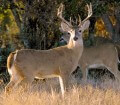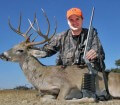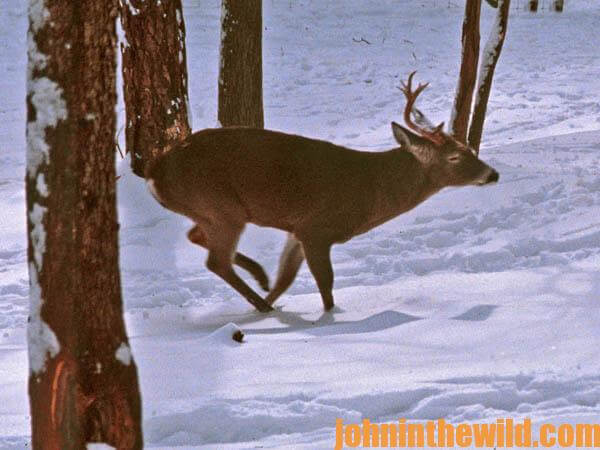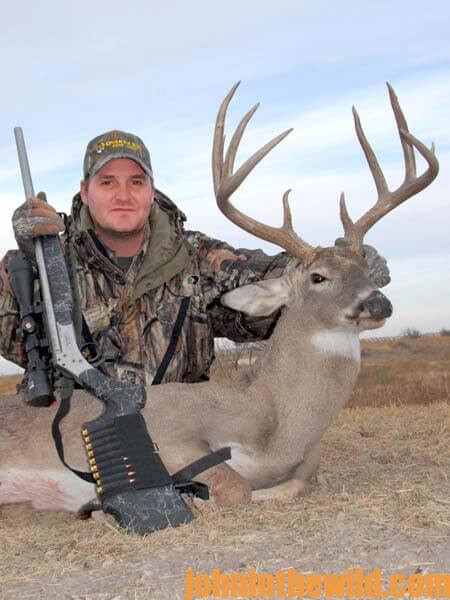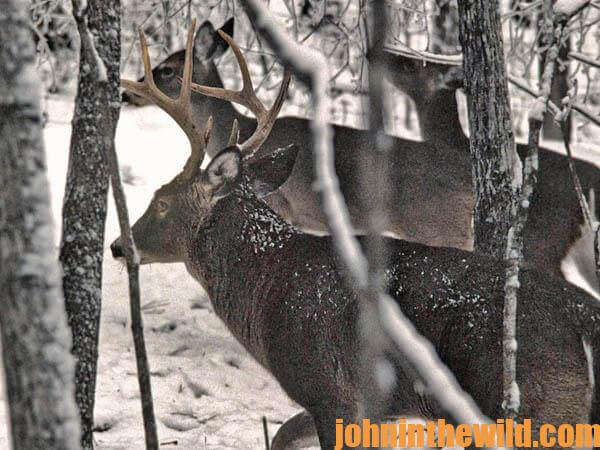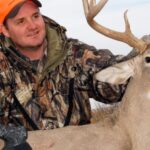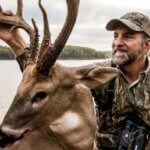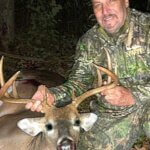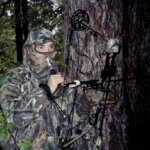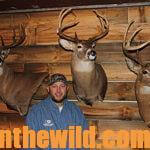John’s Note: When snow falls, and the temperature drops, you’ll find hugging a heater much-more appealing than leaning-up against the bark of an icy tree to take a buck with your bow. In cold-weather conditions, you must make staying warm your first concern without wearing too-many bulky clothes. You also must know what the deer do under these weather conditions for you to locate and take them. These top hunters I’ve interviewed hunt in the ice and snow every year. Here’s the bowhunting tactics they’ve used that have given them success in cold, bad weather.
Why Wear Snow Camo:
“I always wear snow camo when I’m hunting in the snow, because an area with snow becomes mainly black and white,” Chris Kirby, the president of Quaker Boy Calls in New York, advises. “Even if a deer looks-up at you in a tree or spots you on the ground within 5 or 6 feet of him, he probably won’t be able to see you, if you’re wearing snow camo.”
How to Call Deer in the Snow:
“Usually you’ll encounter snow during the rut when the bucks will be fighting in our section of the country,” Kirby observes. “Instead of using a grunt call or rattling antlers in the rut, I prefer to use a bleat call – both the doe bleat and the fawn bleat. I like these two calls, since I believe bucks usually are more interested in locating does than finding fights. The buck knows that does are in estrus during the rut and is looking for a hot doe. So, by using the doe bleat, I believe that my chances of calling a buck are much greater than using other types of calls when I’m hunting deer during the rut. If I’m hunting deer during the pre-rut, then I’ll use the grunt call and the rattling antlers, because that’s the time of year when the buck is defining his territory and wants to run off all the intruders.
“Another advantage of using the bleat call during the rut is that when a buck comes in to the bleat call, he’ll be less cautious than if he comes in to a grunt call or rattling antlers. I also like to use the bleat call during the rut when I want to simply bag a buck, not necessarily take the biggest buck on the property. The bleat call will cause a subordinate buck to come in as well as a dominant buck. However, if a subordinate buck hears a grunt call, he may shy-away from that region. Any time you bleat to deer, you’re calling younger bucks and does. However, if an older-age-class buck is nearby, he’ll also come in to investigate. The bleat call doesn’t repel any bucks like the grunt call or rattling antlers may. When I’m bowhunting in bad winter weather, I may see a deer at 60 to 100 yards that I won’t have an opportunity to take. But, I can use the bleat call to bring that deer to within bow range.”
Why Shoot from a Sitting Position:
“I try and set all my tree stands up to allow me to shoot my bow from a sitting position,” Kirby says.”I always like to put my stand up above the first Y in the limbs of the tree. I want to have branches and cover around me to keep the deer from seeing me when it does look up. I like to place my tree stand in a tree at least as wide as my shoulders. 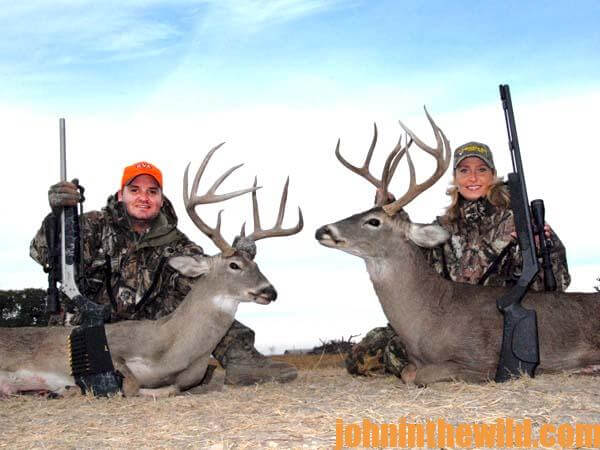 Once I’ve got my stand set, when I get ready to take the deer, I want to make as little movement as possible to get off the shot, because the trees don’t have leaves in the late season. I always practice shooting from a sitting position. The only movement I want to make is straightening my left arm and pulling the string back.
Once I’ve got my stand set, when I get ready to take the deer, I want to make as little movement as possible to get off the shot, because the trees don’t have leaves in the late season. I always practice shooting from a sitting position. The only movement I want to make is straightening my left arm and pulling the string back.
“Oftentimes when you’re hunting in the late season, regardless of how slowly you move, just the movement of drawing the bow back will cause the buck to spot you. When this happens, don’t panic. The deer may have seen movement. But more than likely, if you’re wearing snow camo, he won’t understand what that movement is. Too, in most situations, if you continue to draw the bow, you’ll have time to get it all the way back and anchored, put the pin on the place you want to hit and release the arrow without the deer’s spooking out of the area. If the deer is at 8 or even 12 yards, you usually can aim at the spot you want to hit, and the deer won’t be able to jump the string. But if the deer is at more than 12 yards, you may want to aim at the lower half of the animal. Then if the buck does squat to jump, your arrow will still hit him in the kill zone.”
Click here to get “How to Hunt Deer Up Close: With Bows, Rifles, Muzzleloaders and Crossbows” and “Deer and Fixings” by John E. Phillips.
About the Author
John Phillips, winner of the 2012 Homer Circle Fishing Award for outstanding fishing writer by the American Sportfishing Association (AMA) and the Professional Outdoor Media Association (POMA), the 2008 Crossbow Communicator of the year and the 2007 Legendary Communicator chosen for induction into the National Fresh Water Hall of Fame, is a freelance writer (over 6,000 magazine articles for about 100 magazines and several thousand newspaper columns published), magazine editor, photographer for print media as well as industry catalogues (over 25,000 photos published), lecturer, outdoor consultant, marketing consultant, book author and daily internet content provider with an overview of the outdoors. Click here for more information and a list of all the books available from John E. Phillips.

